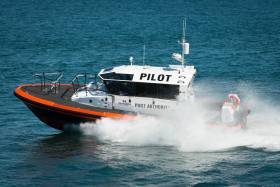Displaying items by tag: Stena Line Ports
At the Port of Holyhead, operated by Stena Line Ports which has revealed plans for major repair works to Europe’s longest breakwater, which includes changing its appearance to ensure it continues to protect the north Wales town.
The ferry port and town of Holyhead on Anglesey are shielded from the elements by the 1.7 mile 19th century Grade II listed structure, with the rubble used to form its foundations coming from the northern side of Mynydd Twr (Holyhead Mountain).
But according to developers, the current maintenance regime is "unsustainable" and "no longer matches the rate of erosion to its foundations," warning that only such a scheme would provide a long term solution and prevent the risk of breaches over the next 15 years.
As a result, Stena Line Ports Ltd has now submitted a Listed Building Consent application to carry out the work to secure the breakwater for the foreseeable future.
NorthWalesLive has more on the plans to repair the breakwater which was completed in 1873.
Ferryport Invests in New Pilot Boat at Holyhead
#ferryport - An investment in a new pilot boat to be used at the north Wales ferryport of Holyhead Port took place last month.
The boat built by Holyhead Marine Services Ltd is to a design created by Camarc Design and will be used by Stena Line for pilotage operations in and out of the Port of Holyhead.
Afloat adds that asides ferryport operations see report, large cruiseships call to the port by anchoring offshore. In addition smaller sized ships can berth in the harbour's inner basin.
The pilot boat is 13 metres in length with a max speed of over 27 knots. At these speeds the boat will be fast and efficient in the role of transferring up to four pilots and two crew members to and from ships arriving and departing Port of Holyhead.
Captain Wyn Parry, Stena Line’s Irish Sea South Ports Manager said: “We’re delighted that our acquisition of the new pilot boat in Holyhead has allowed us to invest in and support the local economy. It was important for Stena Line to try and support the local maritime industry where possible and we are delighted with the design and build quality that Holyhead Marine Services have been able to provide for us."
"The new pilot boat will prove essential to the daily operations of the port in terms of embarking and disembarking the ports pilots safely on and off the ships they help guide into and out of the harbour.”
Nick Colin York, Managing Director of Holyhead Marine Services Ltd commented: “We’re very proud of the hard work that has gone into the building and design of the new pilot boat. It features a resiliently mounted wheelhouse which will give crew a comfortable and quiet working environment and a Popsure fender system which will add to the safety of operations as it spreads impact loads over a large area.”
“This craft is a welcome addition to Holyhead Marine’s portfolio of composite pilot boats designed by Camarc Design and has extended the existing range to include this smaller and more economic model. In keeping with maritime tradition, the Port Authority has christened the new boat and called it St Columba,” added Nick.






























































